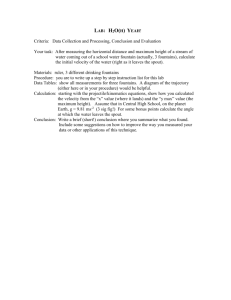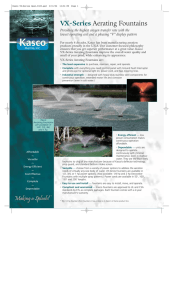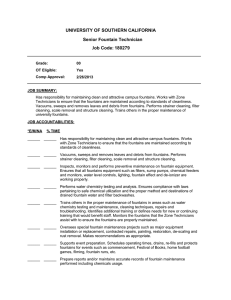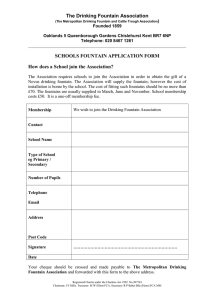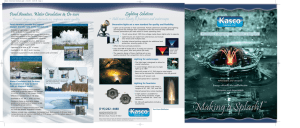Aerators, Aerating Fountains and Display Fountains - Air-O
advertisement
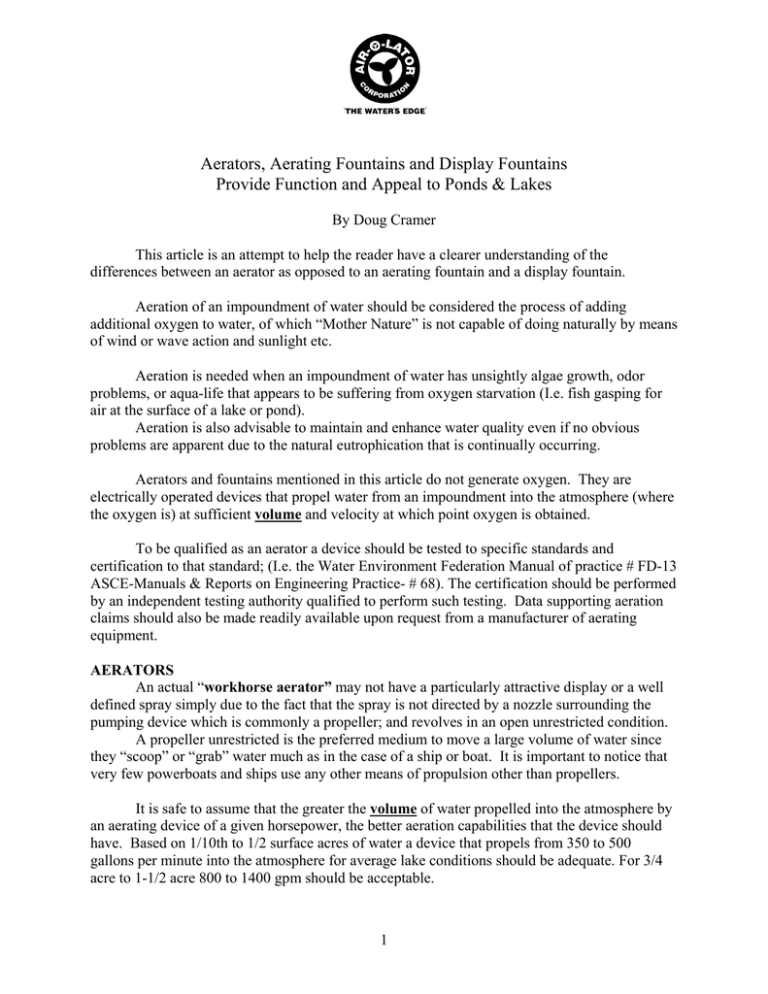
Aerators, Aerating Fountains and Display Fountains Provide Function and Appeal to Ponds & Lakes By Doug Cramer This article is an attempt to help the reader have a clearer understanding of the differences between an aerator as opposed to an aerating fountain and a display fountain. Aeration of an impoundment of water should be considered the process of adding additional oxygen to water, of which “Mother Nature” is not capable of doing naturally by means of wind or wave action and sunlight etc. Aeration is needed when an impoundment of water has unsightly algae growth, odor problems, or aqua-life that appears to be suffering from oxygen starvation (I.e. fish gasping for air at the surface of a lake or pond). Aeration is also advisable to maintain and enhance water quality even if no obvious problems are apparent due to the natural eutrophication that is continually occurring. Aerators and fountains mentioned in this article do not generate oxygen. They are electrically operated devices that propel water from an impoundment into the atmosphere (where the oxygen is) at sufficient volume and velocity at which point oxygen is obtained. To be qualified as an aerator a device should be tested to specific standards and certification to that standard; (I.e. the Water Environment Federation Manual of practice # FD-13 ASCE-Manuals & Reports on Engineering Practice- # 68). The certification should be performed by an independent testing authority qualified to perform such testing. Data supporting aeration claims should also be made readily available upon request from a manufacturer of aerating equipment. AERATORS An actual “workhorse aerator” may not have a particularly attractive display or a well defined spray simply due to the fact that the spray is not directed by a nozzle surrounding the pumping device which is commonly a propeller; and revolves in an open unrestricted condition. A propeller unrestricted is the preferred medium to move a large volume of water since they “scoop” or “grab” water much as in the case of a ship or boat. It is important to notice that very few powerboats and ships use any other means of propulsion other than propellers. It is safe to assume that the greater the volume of water propelled into the atmosphere by an aerating device of a given horsepower, the better aeration capabilities that the device should have. Based on 1/10th to 1/2 surface acres of water a device that propels from 350 to 500 gallons per minute into the atmosphere for average lake conditions should be adequate. For 3/4 acre to 1-1/2 acre 800 to 1400 gpm should be acceptable. 1 It is important to note for aeration purposes that if a lake requires more horsepower due to a greater size, or the problem within the lake is severe, multiples of smaller units should be considered as opposed to one unit of a larger horsepower. This concept permits dispersal of oxygen obtained from the atmosphere more evenly around the body of water and better mixing of the impoundment. AERATING FOUNTAINS Aerating fountains are a combination of the “workhorse aerator” and a fountain and commonly have a spray pattern that appears to have flair to it similar to a trumpet or tuba. A propeller is appropriately used on this type of equipment. However, the flow of water is directed in some brands through a conical shaped tube to a deflector designed to disperse the water in the pattern outlined above by virtually stopping the flow of water and redirecting it at a predetermined angle as is achieved in a plumbing elbow. Other manufacturers use what is commonly termed a “converging” nozzle that allows the propeller to rotate in a chamber and then forces the water pumped by the propeller to a discharge opening of a smaller dimension at the nozzle discharge with minimal volume loss, greater height and diameter for the horsepower used. The latter is this writer’s preferred design simply due to the fact that more water can be discharged with less restriction. Always keep in mind that it is the greater the volume of water that is being placed into the atmosphere that is paramount for a device to aerate any sizable body of water. DISPLAY FOUNTAINS There are fountain products that sometimes claim to be aerators. However the water volume that they are capable of moving is so minimal that even though they may be considered aerated by the manufacturers, won’t make any measurable difference overall within the impoundment or the oxygen level within the impoundment. This type of device is what should be appropriately described as a Display Fountain and can have many spray patterns available. Generally the choice of spray pattern is left up to the potential owner’s discretion since what one person or persons perceive as attractive is not always viewed in the same light by others. This type of device should not be envisioned or promoted as an aerator. In this instance if you require aeration but you want a decorative pattern as well, a combination both devices (fountain aerators and decorative fountains) is perfectly acceptable and is very attractive and functional. Doug Cramer is President / CEO of Air-O-Lator Corporation of Kansas City, Missouri, USA the “CITY OF FOUNTAINS”. Air-O-Lator Corporation has been manufacturing floating surface aerators, mixers, aspirators and fountains since 1967. Copyright 02/04/05 2
